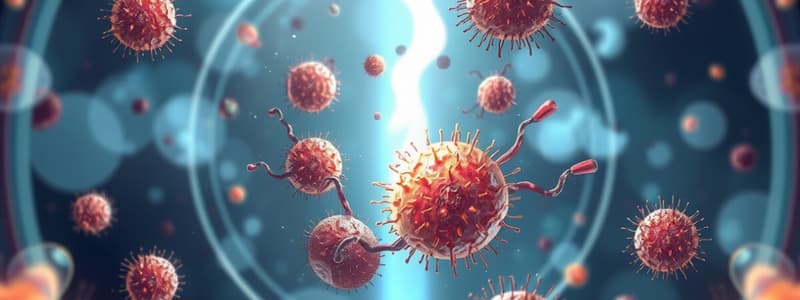Podcast
Questions and Answers
What is a microorganism?
What is a microorganism?
Small, living organism
What is a pathogen?
What is a pathogen?
Illness-causing microorganism
What is a toxin?
What is a toxin?
Poison
Which microorganisms can contaminate food and cause foodborne illness? (Select all that apply)
Which microorganisms can contaminate food and cause foodborne illness? (Select all that apply)
Match the components of FAT TOM with their definitions:
Match the components of FAT TOM with their definitions:
What temperature range do foodborne microorganisms grow well in?
What temperature range do foodborne microorganisms grow well in?
What pH level do foodborne microorganisms grow best in?
What pH level do foodborne microorganisms grow best in?
Foodborne microorganisms do not need moisture to grow.
Foodborne microorganisms do not need moisture to grow.
What two conditions of microorganism growth can be controlled?
What two conditions of microorganism growth can be controlled?
What results from foodborne infections?
What results from foodborne infections?
What are foodborne intoxications?
What are foodborne intoxications?
Which of the following are basic characteristics of bacteria that cause foodborne illness? (Select all that apply)
Which of the following are basic characteristics of bacteria that cause foodborne illness? (Select all that apply)
Spores can resist heat and survive cooking temperatures.
Spores can resist heat and survive cooking temperatures.
Flashcards are hidden until you start studying
Study Notes
Microbial Contaminants
- Microorganisms are small, living entities that can contaminate food.
- Pathogens are illness-causing microorganisms.
- Toxins are poisonous substances that can result from certain microorganisms.
Types of Microorganisms
- Common contaminants include bacteria, viruses, parasites, and fungi.
FAT TOM: Requirements for Microorganism Growth
- Food: Microorganisms require carbohydrates and proteins, commonly found in meat, poultry, dairy, and eggs.
- Acidity: Optimal growth occurs in foods with a neutral to slightly acidic pH (4.6 to 7.5).
- Temperature: Ideal growth temperature ranges from 41°F to 135°F (5°C to 57°C).
- Time: Microorganisms need at least 4 hours in the temperature danger zone (TDZ) for significant growth.
- Oxygen: Some microorganisms need oxygen; others thrive in its absence.
- Moisture: High moisture levels, indicated by water activity (aw of 0.85 or higher), are necessary for growth.
Controlling Microbial Growth
- Control temperature by refrigerating or freezing food properly and cooking food thoroughly.
- Limit food's time in the temperature danger zone (TDZ) to minimize growth.
Classifying Foodborne Illness
- Foodborne Infections: Caused by eating food with pathogens that grow in the intestines.
- Foodborne Intoxications: Result from consuming food containing pre-formed toxins.
- Foodborne Toxin-Mediated Infections: Occur when pathogens produce toxins after ingestion.
Pathways of Contamination
- Contamination can occur person-to-person, through sneeze/vomit exposure, or via dirty surfaces and equipment touching food.
Bacteria Characteristics
- Bacteria are single-celled, living organisms that reproduce quickly under favorable conditions.
- They can be found in food, water, soil, animals, humans, and insects.
- Some bacteria can survive freezing and may form spores for protection, especially when nutrients are scarce.
Spores
- Spores can resist heat and survive cooking, allowing bacteria to revert to a growing form when conditions are favorable, such as improper food storage.
Major Foodborne Illnesses
- Certain bacteria are significant contributors to foodborne illnesses, necessitating awareness and control measures in food safety.
Studying That Suits You
Use AI to generate personalized quizzes and flashcards to suit your learning preferences.




